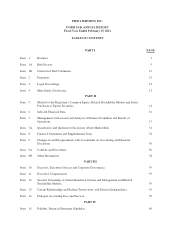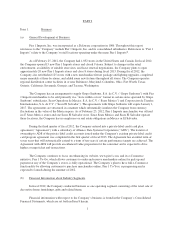Pier 1 2012 Annual Report Download - page 16
Download and view the complete annual report
Please find page 16 of the 2012 Pier 1 annual report below. You can navigate through the pages in the report by either clicking on the pages listed below, or by using the keyword search tool below to find specific information within the annual report.Risks Related to Store Profitability
The Company’s success depends, in part, on its ability to operate in desirable locations at reasonable
rental rates and to close underperforming stores at or before the conclusion of their lease terms.
The profitability of the business is dependent on operating the current store base at a reasonable profit,
opening and operating new stores at a reasonable profit, and identifying and closing underperforming stores. For
a majority of the Company’s current store base, a large portion of a store’s operating expense is the cost
associated with leasing the location. Management actively monitors individual store performance and attempts to
negotiate rent reductions to ensure stores can remain profitable or have the ability to rebound to a profitable state.
Current locations may not continue to be desirable as demographics change, and the Company may choose to
close an underperforming store before its lease expires and incur lease termination costs associated with that
closing. The Company cannot give assurance that opening new stores or an increase in closing underperforming
stores will result in greater profits.
Failure to attract and retain an effective management team or changes in the costs or availability of a
suitable workforce to manage and support the Company’s stores and distribution facilities could negatively
affect the business.
The Company’s success is dependent, in a large part, on being able to successfully attract, motivate and retain
a qualified management team and employees. Sourcing qualified candidates to fill important positions within the
Company, especially management, in the highly competitive retail environment may prove to be a challenge. The
inability to recruit and retain such individuals could result in turnover in the home office, stores and the distribution
facilities, which could have a negative effect on the business. Management will continue to assess the Company’s
compensation and benefit program in an effort to attract future qualified candidates and retain current experienced
management team members. The focus of the Company’s overall compensation program encourages management to
take a balanced approach on maintaining the Company’s profitability. The Company’s compensation policies,
principles, objectives and practices are not structured to promote inappropriate risk taking by employees; however,
there are no assurances that employees will not engage in taking risks that could negatively impact the Company.
Occasionally the Company experiences union organizing activities in non-unionized distribution
facilities. Similar activities could also occur in the stores. These types of activities may result in work slowdowns
or stoppages and higher labor costs. Any increase in costs associated with labor organization at distribution
facilities could result in higher costs to distribute inventory and could negatively impact merchandise margins.
The Company operates in a highly competitive retail environment with companies offering similar
merchandise, and if customers are lost to the Company’s competitors, sales could decline.
The Company operates in the highly competitive specialty retail business competing with specialty
sections of large department stores, home furnishing stores, small specialty stores and mass merchandising
discounters. Management believes that as it is competing for sales, it does so on the basis of pricing and quality
of products, constantly changing merchandise assortment, visual presentation of its merchandise and customer
service. The Company could also experience added short-term competition when other retailers are liquidating
merchandise for various reasons. If the Company is unable to maintain a competitive position, it could
experience negative pressure on retail prices and loss of customers, which in turn could result in reduced
merchandise margins and operating results.
The Company’s business is subject to seasonal variations, with a significant portion of its sales and
earnings occurring during two months of the year.
Approximately 25% of the Company’s sales generally occur during the November-December holiday
selling season. Failure to predict consumer demand correctly during these months could result in lost sales or
gross margin erosion if merchandise must be marked down significantly to clear inventory.
8
























